
The Piperaceae, also known as the pepper family, are a large family of flowering plants. The group contains roughly 3,600 currently accepted species in 5 genera. The vast majority of species can be found within the two main genera: Piper and Peperomia.
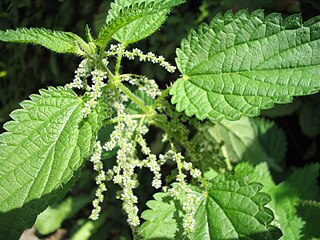
The Urticaceae are a family, the nettle family, of flowering plants. The family name comes from the genus Urtica. The Urticaceae include a number of well-known and useful plants, including nettles in the genus Urtica, ramie, māmaki, and ajlai.
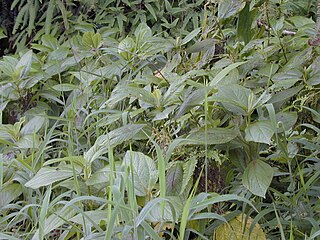
Boehmeria is a genus of 47 species of flowering plants in the nettle family Urticaceae. Of the species, 33 are indigenous to the Old World and 14 to the New World; no species is indigenous to both the Old and New Worlds. The species include herbaceous perennials, shrubs and small trees. Although related to the similar-looking species of the stinging nettles of genus Urtica, species of Boehmeria do not have stinging hairs. Because of the similarity in appearance, some species are commonly called "false nettles".

Thalictrum thalictroides, the rue-anemone, is a herbaceous perennial plant native to woodland in eastern North America. It has white or pink flowers surrounded by a whorl of leaflets, and it blooms in spring.

Pilea, with 600–715 species, is the largest genus of flowering plants in the nettle family Urticaceae.
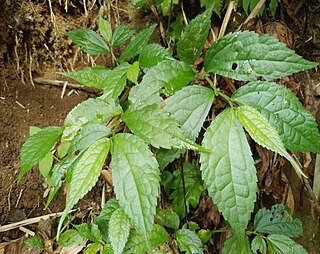
Pilea pumila, commonly known as clearweed, Canadian clearweed, coolwort or richweed, is an herbaceous plant in the nettle family (Urticaceae). It is native to Asia and eastern North America, where it is broadly distributed.

Urtica urens, commonly known as annual nettle, dwarf nettle, small nettle, dog nettle, or burning nettle, is a herbaceous annual flowering plant species in the nettle family Urticaceae. It is native to Eurasia, including the Himalayan regions of Kalimpong, Darjeeling and Sikkim in India and can be found in North America, New Zealand and South Africa as an introduced species. It is reputed to sting more strongly than common nettle.
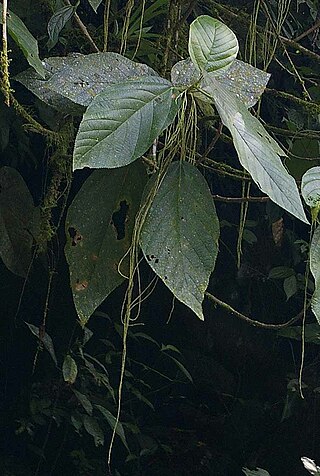
Myriocarpa is a genus woody plant which ranges in size from shrubs to small trees and is endemic to Central and South America. Within the Urticaceae, Myriocarpa is characterized by long pendulous string-like female inflorescences of apparently naked flowers and stems which release a watery latex when cut. Estimates for the diversity of the genus range from five to eighteen species. Research for Flora Mesoamericana indicates that there are probably fifteen to twenty species.

Urera is a genus of flowering plants in the nettle family, Urticaceae. It has a pantropical distribution.

Parietaria is a genus of flowering plants in the family Urticaceae, native to temperate and tropical regions across the world.
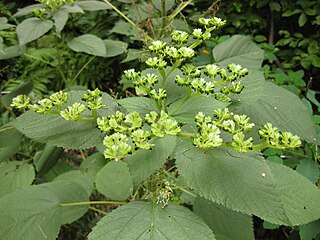
Laportea canadensis, commonly called Canada nettle or wood-nettle, is an annual or perennial herbaceous plant of the nettle family Urticaceae, native to eastern and central North America. It is found growing in open woods with moist rich soils and along streams and in drainages.
Bagassa guianensis is a tree in the plant family Moraceae which is native to the Guianas and Brazil. It is valued as a timber tree and as a food tree for wildlife. The juvenile leaves are distinctly different in appearance from the mature leaves, and were once thought to belong to different species.

Enemion biternatum, commonly known as the false rue-anemone, is a spring ephemeral native to moist deciduous woodland in the eastern United States and extreme southern Ontario.

Galearis rotundifolia is a species of flowering plants in the orchid family, Orchidaceae. It is commonly called roundleaf orchis and small round-leaved orchid. It is a succulent perennial herb native to North America, where it occurs throughout Canada, part of the northern United States, and Greenland.
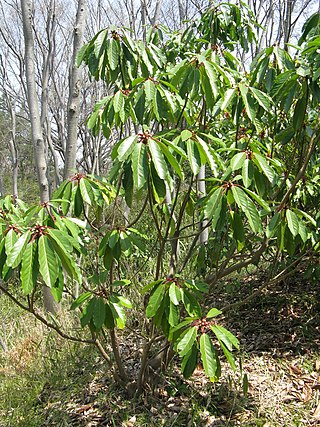
Daphniphyllum macropodum is a shrub or small tree found in China, Japan and Korea. Like all species in the genus Daphniphyllum, D. macropodum is dioecious, that is male and female flowers are borne on different plants. The timber is used in China in construction and furniture making. It is grown as an ornamental plant, chiefly for its foliage.

Urtica gracilis, commonly known as the slender nettle, tall nettle, or American stinging nettle, is a perennial plant plant without woody stems that is well known for the unpleasant stinging hairs on its leaves and stems. It is native to much of the North America from Guatemala northwards and temperate areas of South America. It is easily confused with the visually very similar Eurasian species Urtica dioica and is still listed in some resources as a subspecies of this plant. However, genetic analysis and experiments show that they are genetically distinct.

Ambrosia salsola, commonly called cheesebush, winged ragweed, burrobush, white burrobrush, and desert pearl, is a species of perennial shrub in the family Asteraceae native to deserts of the southwestern United States and northwestern Mexico.

Urera trinervis (Hochst.) Friis & Immelman is a softly woody dioecious liane, sometimes epiphytic, climbing to 20 m, often to the canopy and hanging in festoons. It is one of some 44 species of Urera belonging to the nettle family Urticaceae. It is known in English as the tree climbing-nettle or climbing nettle.
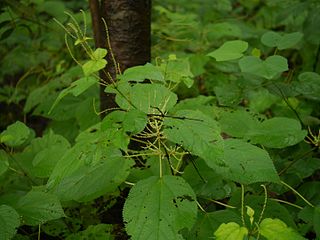
Boehmeria macrophylla is a species of flowering plant in the nettle family Urticaceae, This herbaceous perennial is native to Asia. The flowers are dioecious or monoecious. Its flowering season is from June to September. It is commonly found in forests, thickets, along streams and roadsides. The species as a whole is characterized by the opposite leaves, spike-like inflorescences, and fruiting perianth with a rounded base. The varieties are very distinctive and their status needs more detailed assessment.
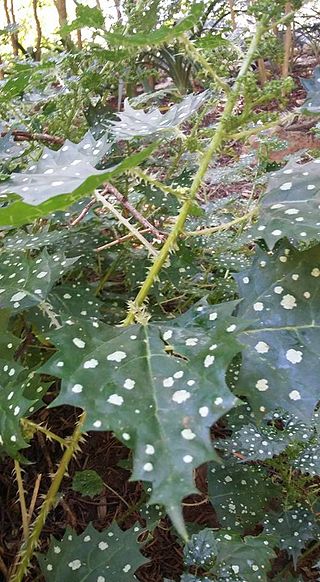
Laportea grossa, or spotted nettle, is an African plant in the family Urticaceae, and one of 31 species in the genus. This species occurs in shady places in coastal and escarpment forests, closed woodland and on streambanks from George through the Eastern Cape, KwaZulu-Natal to southern Mozambique. Young leaves of this species are cooked and eaten as a vegetable.



















